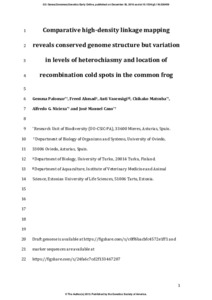Comparative High-Density Linkage Mapping Reveals Conserved Genome Structure but Variation in Levels of Heterochiasmy and Location of Recombination Cold Spots in the Common Frog
Gemma Palomar; Alfredo G. Nicieza; Freed Ahmad; Anti Vasemägi; Chikako Matsuba; José Manuel Cano
https://urn.fi/URN:NBN:fi-fe2021042716322
Tiivistelmä
By combining 7077 SNPs and 61 microsatellites, we present the first linkage map for some of the early diverged lineages of
the common frog, Rana temporaria, and the
densest linkage map to date for this species. We found high homology
with the published linkage maps of the Eastern
and Western lineages but with differences in the
order of some markers. Homology was also strong with the genome of the
Tibetan
frog Nanorana parkeri and we found high synteny with the clawed frog Xenopus tropicalis.
We confirmed marked heterochiasmy between sexes and detected
non-recombining regions in several groups of the male linkage
map. Contrary to the expectations set by the male
heterogamety of the common frog, we did not find male heterozygosity
excess
in the chromosome previously shown to be linked to
sex determination. Finally, we found blocks of loci showing strong
transmission
ratio distortion. These distorted genomic regions
might be related to genetic incompatibilities between the parental
populations,
and are promising candidates for further
investigation into the genetic basis of speciation and adaptation in the
common frog.
Kokoelmat
- Rinnakkaistallenteet [19207]
